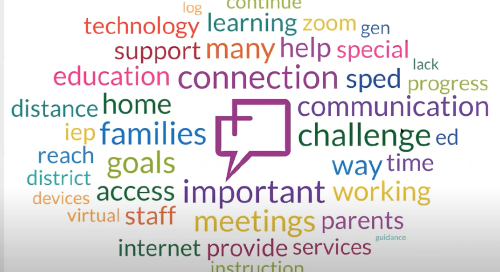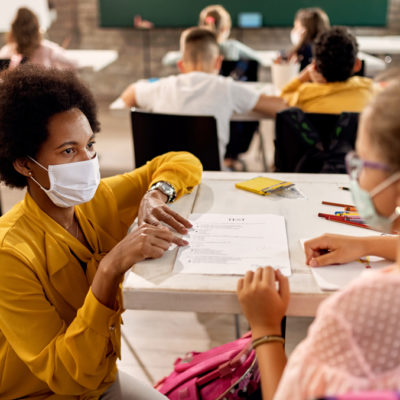This resource is provided by ACSA Partner4Purpose Navigate360.
The COVID-19 pandemic has reshaped society as we know it. Besides the obvious physical effects of the virus — and the measures being put in place to protect people and limit its spread — the pandemic is also taking a toll on the mental health of people everywhere, especially kids. With sweeping changes made to their education, socialization and home lives, children are struggling with stressors they’ve never faced, and they’re feeling new levels of anxiety and depression as a result. In short, the pandemic has contributed to the creation of a true mental health crisis for students in this nation.
Youth Mental Health: A National Emergency
In December 2021, the U.S. Surgeon General released a public health advisory containing findings related to the mental health of young people before and during the pandemic. According to the advisory, there was a 40% increase in “persistent feelings of sadness or hopelessness” among youth from 2009 to 2019. It also states that in 2016, roughly half of the 7.7 million children with treatable mental health disorders “did not receive adequate treatment.”
The “unfathomable number of deaths, pervasive sense of fear, economic instability, and forced physical distancing from loved ones, friends, and communities” brought on by the pandemic have made teens’ mental health struggles of the past decade even worse, according to the advisory. Since the start of the pandemic, 25% of youth surveyed experienced depressive symptoms and 20% reported feeling anxious — in both cases, more than double the pre-pandemic rate.
The youth mental health crisis is also being recognized as a national emergency. In October 2021, the American Academy of Pediatrics (AAP), American Academy of Child and Adolescent Psychiatry (AACAP) and the Children’s Hospital Association (CHA) declared a national emergency in children’s mental health, stating that the pandemic “has intensified this crisis: Across the country we have witnessed dramatic increases in Emergency Department visits for all mental health emergencies including suspected suicide attempts.”
With a global pandemic making life even more challenging for an age group that was already experiencing rising mental health issues, it is imperative that schools understand what is happening and make plans to address the crisis on their own campuses.
What Causes Teen Anxiety & Depression?
Besides the pandemic’s complete overhaul of modern life and disruption to routines, youth face other challenges to their mental health and wellness on a daily basis.
Academic Stressors
High expectations from both parents and schools can take a toll on students’ mental health as they try to keep up with what’s demanded of them. The pressure to maintain high grades often comes from an instilled fear of not getting into a good college, failing classes or living up to the expectations of a parent or teacher. This can impact a student’s mental health as they sacrifice their sleep, diets, social lives and schedules to make it all work.
On the other hand, schools and classrooms that do not set expectations for students can leave students unprepared for the future. This can also cause stress once a student is faced with a challenge they aren’t prepared for.
Feeling Unsafe at School
According to a 2021 poll by Navigate360 and John Zogby Strategies, many school-aged children simply don’t feel that safety is a true priority at their schools. Here are more sobering figures from this poll:
- Only 37% of teens believe their schools have comprehensive plans in place for an emergency
- Only 32% of teens believe their schools can handle an incident of self-harm or suicide
In the poll, 58.4% of students surveyed are concerned about their mental health — and of the students surveyed, roughly one third reported that they do not get adequate mental health support at home. Additionally, 38% of students surveyed said they don’t feel their schools are meeting their mental health needs.
Digital Safety & Mental Health
Today’s youth (largely Generations Z and Alpha) didn’t just learn to adapt to an increasingly online world — they grew up in it and have been raised largely by the Internet. While this has given them plenty of resources for education, entertainment and social interaction, it has also created an avenue for bullying and harmful content that is negatively affecting their mental wellbeing. A 2018 study conducted by Pew Research Center found that 59% of teens have experienced at least one of six types of cyberbullying:
- Name-calling (42%)
- False rumors (32%)
- Receiving explicit images without consent (25%)
- Constantly being asked where they are, what they’re doing, etc. by someone other than a parent (21%)
- Physical threats (16%)
- Having their own explicit images shared without consent (7%)

Even though our youth has an incredibly deep understanding of modern technology and the way the Internet works, students and school staff have had to adapt to remote learning forced upon them by the pandemic. The complete disruption to the in-person, interactive, collaborative learning style many were used to receiving has given many students trouble as their schools work to piece together a brand-new education style with no roadmap or precedent to refer to.
Problems at Home
Youth who have turbulent home lives that include physical and/or emotional abuse, food or housing insecurity or community areas prone to violence are constantly dealing with stress and anxiety. COVID-19 has only made things worse by adding more stressors to these students’ already full plates.
Other Causes
The U.S. Surgeon General’s health advisory lists these other pandemic-related causes of mental health struggles:
- Living in areas with severe COVID-19 outbreaks
- Having parents/caregivers who are frontline workers
- Worrying about getting COVID-19
- Losing a loved one to COVID-19
- Increased parenting demands leading to burnout
- Worsening of adverse childhood experiences, financial instability, food shortages or housing instability
Concerningly, students today are lacking confidence in their safety at school. According to a December 2021 Zogby/Navigate360 poll:
- Only 13.6% have the greatest confidence that their school is spending enough time and money to keep them safe
- Only 12.5% have the greatest confidence that their school is doing their best to create an atmosphere of emotional safety
Creating a positive, safe school climate is key for schools to properly meet their students’ mental health and wellbeing needs. Schools must be well-equipped to achieve positive outcomes amidst the youth mental health crisis and quite possibly save lives by getting kids access to the invaluable resources they need. When school staff members know when and how to get help for their students, it’s much easier for students to feel confident in their physical, social and emotional safety.
Learn about Navigate360’s school safety solutions that provide accessible, integrated and relevant tools necessary to save and enhance lives. Download this guide to learn how you can address youth mental health issues on your campus by investing in proven threat detection and prevention solutions and students’ mental wellbeing.









Leave a Comment